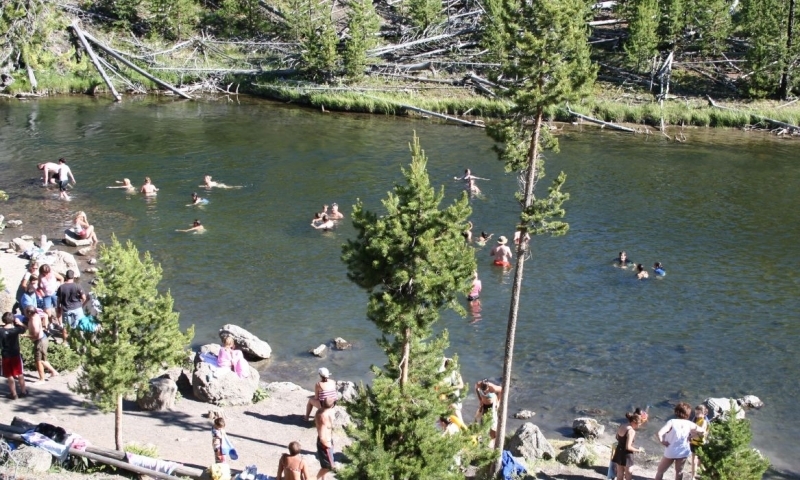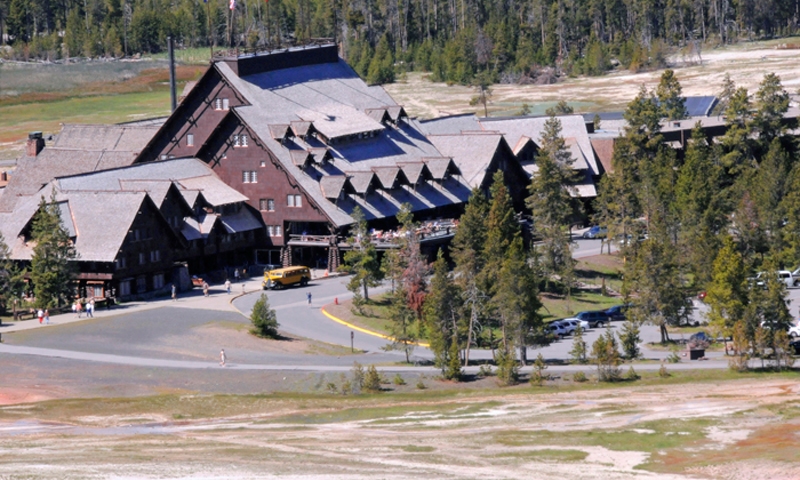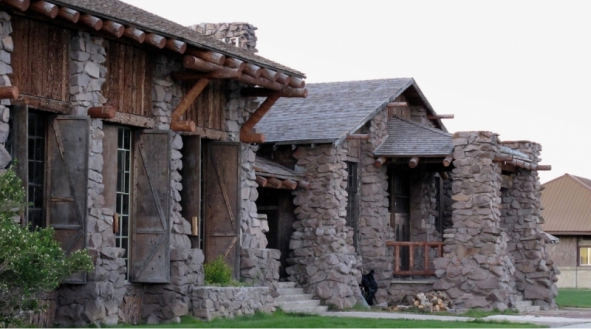Yellowstone National Park Tourism Attractions
Attractions are endless in Yellowstone. Explore each region within the park for a unique experience and visit sites like Old Faithful, Mammoth Hot Springs and Grand Canyon of Yellowstone.
Some 350 miles of paved road wind through the park, crossing the Continental Divide three times and looks much like a figure 8; the upper and the lower grand loops. There are 7 major areas or districts, within Yellowstone National Park where the majority of the major attractions are found. Most will be located on the lower loop.
Below is the listing of the 7 districts, an overview of what you will find in each and a more specific sampling of the attractions in each district.
Madison District
The Madison district is best known for its fly-fishing, and wildlife.
- Lower Geyser Basin / Fountain Paint Pots
The Lower Geyser Basin is scattered over a fairly large area and features regularly erupting geysers, hot springs, and a fascinating mud pool, which often strikes visitors as something from another world. - Madison River
The Madison River flows between Madison and West Yellowstone and offers one of the most scenic entrances to the park. Pull off the road for a picnic or to test your luck at fishing.
Old Faithful District
Old Faithful district is where you will spend most of your time viewing geysers, hot springs, steam vents "fumaroles", and paint pots, views along the Firehole River as well as wildlife.
- Predictable Geysers
The naturalist staff predicts only five major geysers regularly. They are Castle, Grand, Daisy, Riverside, and Old Faithful. - Old Faithfull Inn
The building is a rustic log and wood-frame structure with gigantic proportions: nearly 700 feet in length and seven stories high. - Visitor Education Center
One of the most informational centers in the park, you'll enjoy a movie theater, shop, and many interesting exhibits. - Lower Hamilton Store
Built in 1897; this is the oldest structure in the Old Faithful area still in use. - Nez Perce Creek Wayside
This exhibit tells the story of the flight of the Nez Perce through Yellowstone in 1877. - Firehole River
The river derives its name from the steam (which they thought was smoke from fires) witnessed by early trappers to the area.
Lake District
The Lake District would include Yellowstone Lake as well as hot springs, fumaroles, and possibly bears.
- Yellowstone Lake
This is the largest high-altitude lake in the lower 48 states, and it is breathtaking. - West Thumb Geyser Basin
This geyser basin features some interesting thermal features, including several, which are in Yellowstone Lake itself. It also offers a good view of the Lake. - Lake Yellowstone Hotel
The Lake Yellowstone Hotel is Yellowstone's oldest surviving hotel that is still in use. Lake Yellowstone Hotel was first started serving guests in 1891.
Canyon District
Within the Canyon district you will find one of the better high elevation grazing meadows in Yellowstone; Hayden Valley. Large bison herds roam this area. The Canyon district is also known for its famous waterfalls, deep canyon, high elevation mountain pass and sweeping vistas as well as bears, elk and other wildlife.
- The Grand Canyon of the Yellowstone
The Grand Canyon of the Yellowstone is one of the more impressive sights found in Yellowstone Park and one of the most popular. It is famous for its colors, shapes, and waterfalls.
Norris District
The Norris district will include Norris Geyser basin, one of the more dynamic geothermal basins within Yellowstone as well as open meadow scenes with wildlife and views along the Gibbon River.
- Norris Geyser Basin
Norris Geyser Basin is one of Yellowstone's most popular geyser basins; Norris is home to Steamboat (the world's tallest geyser).
Mammoth District
Mammoth district is home to Yellowstone Park headquarters and historical buildings as well as wildlife, and the famous travertine terraces.
- Mammoth Hot Springs
Mammoth Hot Springs are the main attraction of the Mammoth District. These features are quite different from thermal areas elsewhere in the park. The thermal activity here has formed terraces, which appear yellow in color and often have herds of elk meandering on them
Tower/Roosevelt District
The Tower / Roosevelt district is best known for its wildlife, waterfall and river scene as well as geologic evidence left behind by past volcanic eruptions. This district is considered to be the lower elevation for Yellowstone, and is spring/winter range for numerous species of wildlife.
- Tower Fall
This is the most popular waterfall in Yellowstone other than the Lower Falls of the Grand Canyon. - Lamar Valley
One of the most scenic valleys in the park and great for viewing wildlife.
And Wildlife Everywhere
Yellowstone Park is also home to abundant and varied wildlife, unlike anywhere else in America. Nearly all wildlife species that inhabited the park when it was first explored over 100 years ago survive today.
Questions & Answers
Each park is unique in its own right. Yellowstone has world-famous geysers and hotsprings that can’t be found anywhere else. However, the popular visitor areas are often fairly easy walks. Glacier offers a more rugged experience with more rigorous hiking, greater sense of adventure, and an enriching taste of mountain culture.
Yes, Yellowstone is a bucket list trip for a reason. Yellowstone hosts one-of-a-kind natural wonders that have fueled the imaginations of artists, explorers, and travelers alike for generations. As the United States’ first national park, Yellowstone is a treasure chest of natural wonders you can only unlock by visiting it in person.
Dozens of features and locations in Yellowstone should stop you in your tracks. You could easily spend a week in Yellowstone and still only scratch the surface, which is why visitors keep coming back for more. Common items on people’s must-see list of Yellowstone include the following:
- Old Faithful Geyser and the Upper Geyser Basin
- Grand Prismatic Spring
- Grand Canyon of Yellowstone
- Lamar Valley (for wildlife sightings)
- Mammoth Hotsprings
- Roosevelt Arch
- Lower Geyser Basin
- Yellowstone Lake
- Tower Fall
The jagged spires of Grand Teton National Park are a stone’s throw outside Yellowstone. Exciting in their own way, each gateway town outside of Yellowstone’s entrance gates offer their own exciting attractions and outdoor recreation opportunities. Gardiner, Montana is famed for its river rafting experiences. If you missed seeing live wolves and bears within the park, check out the creatures at the Grizzly Discovery Center in West Yellowstone, Montana. Cody, Wyoming is home to the Buffalo Bill Museum and the largest zipline in the state. Silver City/Cooke City, Montana is home to an old-time outpost that’s been operating since the late 1800s and still has the feel of an old mining outpost. And Jackson, Wyoming is a major outdoor capital.
Yellowstone National Park is famous for its surreal geysers, boiling mud pits, hot springs, and waterfalls. From its peculiar geologic features to its untamed wilderness and wildlife, Yellowstone is unlike anywhere else on the planet.
If you want breath-taking picturesque mountain landscapes, 200 hundred miles of backcountry trails and heaps of recreational opportunities, head to Grand Teton. For those who want an otherworldly experience, the thermal features in Yellowstone are unlike anywhere else on the planet. Both offer a rich history steeped in mountain culture and surreal wildlife viewing opportunities. But why choose between the two, when you can easily experience both in one trip? Grand Teton National Park is less than 7 miles away from Yellowstone’s South Entrance via the John D. Rockefeller Memorial Parkway.
By using the West Entrance you''ll be able to most easily visit the majority of its thermal features. To the north of Madison Junction is the Norris Geyser Basin. Farther north is Mammoth Hot Springs, a giant hot spring and natural water fountain that built up over millennia. Head south from Madison and you’ll be able to visit Grand Prismatic Spring, Lower Geyser Basin, the Midway Geyser Basin, and the Upper Geyser Basin where you’ll find the world-famous Old Faithful Geyser.












